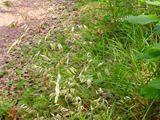Native Plants

Q. Who is Mr. Smarty Plants?
A: There are those who suspect Wildflower Center volunteers are the culpable and capable culprits. Yet, others think staff members play some, albeit small, role. You can torture us with your plant questions, but we will never reveal the Green Guru's secret identity.
Did you know you can access the Native Plant Information Network with your web-enabled smartphone?
Ask Mr. Smarty Plants is a free service provided by the staff and volunteers at the Lady Bird Johnson Wildflower Center.

rate this answer
Tuesday - February 03, 2009
From: Bowie, MD
Region: Mid-Atlantic
Topic: Erosion Control
Title: Native plants to prevent erosion in Maryland
Answered by: Barbara Medford
QUESTION:
Please can you recommend native plants for a north-facing slope, under pine trees? I live in Maryland near the border between the Coastal Plain and Piedmont Plateau, where we have cold to mild Winters and hot, humid Summers, but also frequently have drought conditions. I want to put in native plants to hold this north slope and prevent erosion under the pine trees, but want plants that don't require me watering them once they're established. Attractive/interesting bloom is not essential.ANSWER:
The best plants for your condition are native grasses, especially since you specified that interesting blooms was not an issue. Grasses have fibrous roots, and grab and hold the soil. They do it for selfish reasons, of course, so they will have dirt to live in and perpetuate themselves but you get the advantages also. You are probably already aware that it is difficult to grow much under pine trees, because of their heavy shade and the blanket of needles beneath them. They also, over time, will cause more acidity in the soil. So, we'll check for acid and shade tolerance of the grasses we choose as examples. To find these grasses, we'll go to our Native Plant Database, go down to COMBINATION SEARCH, select Maryland on the drop-down menu, then select "grasses" under Habit and shade to part shade on Light Requirements, then click on "Submit combination search." We will then follow the plant link to each plant's page and check on the acidity or alkalinity of the soil preferred by each grass. You can do the same thing, adding in such specifications as Soil Moisture. We are going to leave the Duration blank, so the database will select both annual and perennial grasses.
These plants, either as plugs or seeds, are all commercially available. If you have difficulty locating them, go to our Native Plant Suppliers section, type your town and state into the "Enter Search Location" box and you will get a list of native plant nurseries, seed suppliers and landscape and environmental consultants in your general area.
GRASSES/GRASS-LIKE PLANTS FOR MARYLAND
Andropogon gerardii (big bluestem) - perennial, 4 to 8 ft. tall, moderately acid and saline tolerant
Andropogon virginicus (broomsedge bluestem) - perennial, 2 to 5 ft. tall
Bouteloua curtipendula (sideoats grama) - perennial, 2 to 3 ft. tall
Bouteloua hirsuta (hairy grama) - perennial, 10 to 18 inches tall
Carex blanda (eastern woodland sedge) - perennial, 1 to 3 ft. tall
Carex texensis (Texas sedge) - perennial, 10 to 12 inches tall
Chasmanthium latifolium (Inland sea oats) - perennial, 2 to 4 ft. tall
Elymus canadensis (Canada wildrye) - cool-season perennial, 2 to 4 ft. tall
Melica nitens (threeflower melicgrass) - perennial, 3 to 5 ft. tall
Muhlenbergia schreberi (nimblewill) - perennial, 1 to 3 ft. tall
Schizachyrium scoparium (little bluestem) - perennial, 1 to 3 ft. tall
Tripsacum dactyloides (eastern gamagrass) - perennial, 2 to 3 ft. tall
More Erosion Control Questions
Steep slope from Charlotte NC
May 03, 2012 - I live near Charlotte, NC and I have a very steep sloped area from the edge of our front yard down to the road. It's a huge eyesore mainly because it is red clay dirt and has nothing growing on it. W...
view the full question and answer
Erosion control plantings in Washington state
September 06, 2007 - Hi,
I am trying to do an eagle project that involves putting vegetation onto a hill to prevent erosion. I live in Washington state where there is plenty of rain so erosion is a big problem. We are t...
view the full question and answer
Solution for erosion on steep slope in California
April 14, 2011 - Dear Mr.Smarty Plants,
I have a serious hillside problem in Santa Cruz County resulting from the recent deluge of rain. Steep to sheer now with no plants left on it after the hill slide washed to th...
view the full question and answer
Controlling erosion in Leburn KY
July 21, 2009 - I would really appreciate advice on controlling a serious erosion problem in eastern Kentucky. The slope is north facing, shady and moist with rich soil. Would prefer to use native Kentucky plants. ...
view the full question and answer
Native Plants for a Steep Slope in TN
July 15, 2014 - Hello, I live in Knoxville, TN and have a very steep slope in our backyard. There is a lot of water erosion causing our grass to be covered with red dirt. I would love to try to plant something on thi...
view the full question and answer
| Support the Wildflower Center by Donating Online or Becoming a Member today. |

